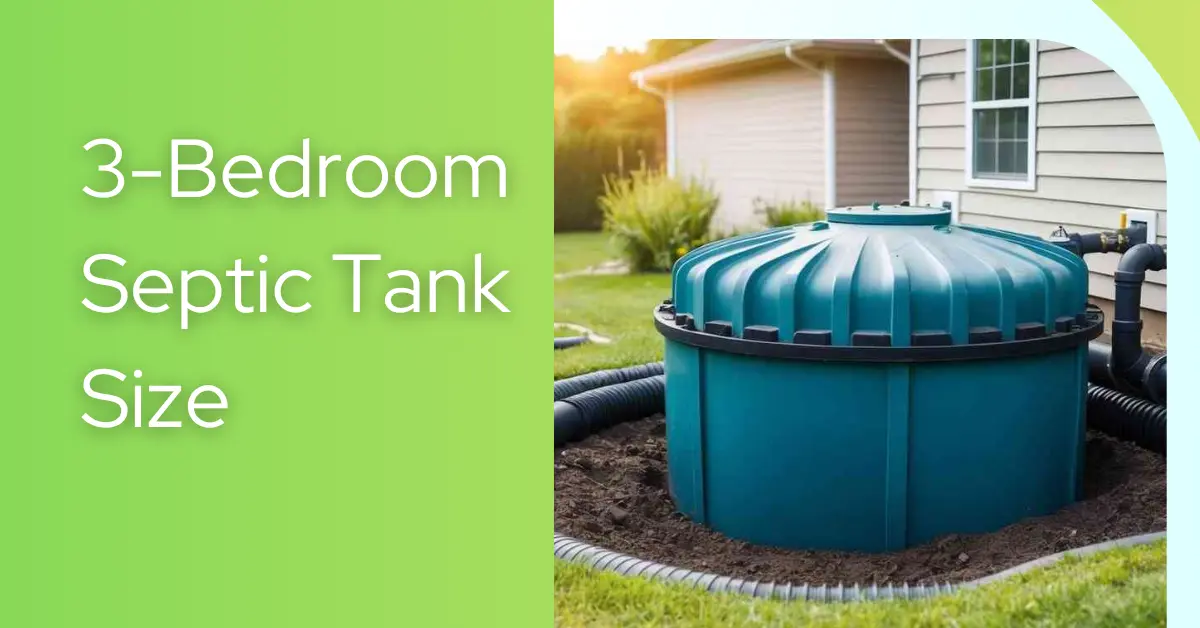Choosing the septic tank size for 3 bedroom house isn’t just about checking a regulatory box; it’s about protecting your home, your wallet, and your peace of mind. Whether you’re building a new home or upgrading an outdated system, your septic tank plays a crucial role in managing household waste effectively.
Go too small, and you risk frequent backups, premature system failure, and costly fines. Oversize it unnecessarily, and you’re paying more than you need to, both upfront and in terms of space.
So what’s the right size for your home? Let’s break it all down from industry standards to household-specific needs so you can make the smartest choice.
Why Septic Tank Size Matters
When it comes to septic systems, size does matter. A properly sized septic tank helps waste break down efficiently, keeps your drain field from becoming overloaded, and ensures you meet all local code requirements. For a 3-bedroom home, you want a system that not only meets minimum guidelines but also accommodates daily water usage, number of residents, and bathroom count.
There’s a general standard for most 3-bedroom homes, but it’s not one-size-fits-all.
What Is the Standard septic tank size for 3 bedroom house?
Most 3-bedroom houses require a septic tank size of 1,000 to 1,250 gallons. This range is widely accepted across the U.S. as a standard, depending on your local climate, soil absorption, household usage, and number of bathrooms.
- 1,000 gallons: This is typically the minimum legal size for a 3-bedroom home and works for lighter water usage.
- 1,250 gallons: Often considered ideal for standard families or homes with 2 bathrooms.
While a 1,000-gallon tank might be enough to meet basic standards, opting for 1,250 gallons adds an important buffer that reduces long-term maintenance and stress on your system.
Septic Tank Size in Gallons, Feet, and Meters
Understanding the dimensions of a tank helps when planning your installation, especially if space is limited. Here’s how standard septic tank sizes break down:
Gallons
- Most common sizes for a 3-bedroom home: 1,000 to 1,250 gallons. For reference, smaller tanks like the 500 gallon septic tank exist, but they’re typically too small for residential use.
Feet
- Length: 8 to 9 feet
- Width: 5 to 6 feet
- Depth: 4 to 6 feet (varies based on manufacturer and model)
Meters
- Length: 2.5 to 2.75 meters
- Width: 1.5 to 1.8 meters
These figures may slightly change depending on the shape (cylindrical or rectangular) and whether you choose concrete, plastic, or fiberglass construction.
Read also
Does the Number of Bathrooms Matter?
Yes, the number of bathrooms significantly affects septic tank sizing. If you’re researching the septic tank size for 3 bedroom 2-bath house, you should lean toward the 1,250-gallon range or even more if your household tends to use water heavily.
Each additional bathroom means:
- More toilet flushing
- Additional shower and sink use
- Higher total daily wastewater output
Many states automatically bump up the required tank size for homes with more than one full bath. Ignoring this can not only overwork your septic system but may also result in building code violations during inspections or resale.
Local Regulations May Affect Required Size
You might think a 1,000-gallon tank is sufficient and in many areas, it is. But local building codes can change everything. Depending on where you live, you might be legally required to install a larger tank than what seems necessary.
For example:
- California: Counties often mandate 1,250 gallons minimum for any 3-bedroom home.
- Florida: Homes with garbage disposals or laundry machines might require a 1,500-gallon tank, even with only 3 bedrooms.
- Northern states: Cold climates sometimes increase required size to handle seasonal volume changes.
Always check with your county health department or building office before installing your system.
Recommended Septic Tank Sizes Based on Household Use
While regulations set the minimum, your family’s water habits should guide your final decision. Let’s break it down by usage:
Light Use (2 – 3 people)
- Recommended Size: 1,000 gallons
- Works well for smaller households with minimal daily water use (e.g., no dishwasher or heavy laundry loads).
Average Use (4 – 5 people)
- Recommended Size: 1,250 gallons
- Accommodates moderate use, including daily showers, dishwashing, and occasional laundry.
High Use (6+ people, water-heavy appliances)
- Recommended Size: 1,500 gallons or more
- Needed for larger families, frequent visitors, or homes with extra appliances like jacuzzis, washers, or garbage disposals. For even greater capacity, some homeowners explore the 2000 gallon septic tank cost to future-proof their system.
Choosing a bigger tank than required isn’t always a bad thing. It reduces pump-out frequency and extends the life of your leach field.
What Happens If the Tank Is Too Small?
Opting for a smaller-than-needed tank can lead to a host of problems. While you might save money on installation, you’ll likely spend more on repairs, pumping, and even fines.
Here’s what can go wrong:
Overflow or Backups
When wastewater exceeds your tank’s capacity, it can flow back into your home. That means messy, costly cleanup and serious health risks.
Premature Drain Field Failure
If your tank fills too quickly, solids can pass into the drain field, clogging it. This may require a full system replacement, a major expense.
More Frequent Pumping
Tanks that fill fast need to be pumped more often, sometimes every 6 months instead of every 3–5 years.
Code Violations and Fines
In many areas, installing an undersized tank can lead to failed inspections, fines, or resale delays.
Septic Tank Size Calculator Tools
Online septic tank size calculators are becoming popular with DIY homeowners. These tools estimate the right tank based on:
- Bedrooms
- Bathrooms
- Occupants
- Daily water use
However, they’re not foolproof. Many fail to factor in local laws, soil absorption rates, or climate. Some don’t even ask about garbage disposals, which can drastically change your needs.
Use them as a starting point, but always follow up with a professional septic installer or county official to get an accurate recommendation.
Final Recommendation
If you’re trying to pin down the right septic tank size for a 3-bedroom house, the sweet spot is usually 1,250 gallons. It offers a strong balance of capacity, flexibility, and compliance, especially if your home has two bathrooms or moderate to high water usage.
Here’s how to make the best choice:
- Start with 1,000 gallons if you live alone or have minimal water needs.
- Go with 1,250 gallons for an average family of four or five.
- Consider 1,500 gallons or more if you have multiple water-hungry appliances or a large household.
And remember: always check your local regulations before breaking ground.
FAQs
What is the recommended septic tank size for a 3 bedroom house?
For a typical 3 bedroom house, the recommended septic tank size is at least 1,000 gallons. This size provides enough capacity to handle the wastewater from an average family of 4-5 people.
Why does the size of a septic tank matter?
The septic tank size affects how efficiently wastewater is processed and how often the tank needs to be emptied. A properly sized tank prevents overflow, system backups, and costly repairs.
Can a smaller septic tank work for a 3 bedroom house?
While smaller tanks exist, they are usually not recommended because they fill up quickly, leading to frequent pumping and potential system failure.
Does local regulation affect septic tank size?
Yes. Local health departments or building codes often specify minimum septic tank sizes based on the number of bedrooms and expected occupancy. Always check your local regulations.
Can I upgrade a septic tank if my family grows?
Yes, septic tanks can be upgraded or expanded to accommodate more people or increased water usage.






